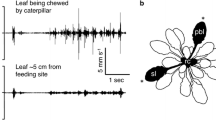Abstract
We investigated the olfactory response of the predatory mitePhytoseiulus persimilis to cucumber leaves infested with prey, the herbivorous spider miteTetranychus urticae. The predators responded to volatiles from young rather than old infested cucumber leaves. GC-MS analysis of the head-space of spider mite-infested, artificially damaged and undamaged cucumber plants showed that herbivore-induced plant volatiles were present among the volatiles of both old and young infested cucumber leaves. The major components of the herbivore-induced plant volatiles were (3E)-4,8-dimethyl-1,3,7-nonatriene and (E)-β-ocimene: these compounds are known to attract the predatory mites. In addition, we found three oximes (2-methylbutanalO-methyloxime, 3-methylbutanalO-methyloxime, and an unknown oxime) in the headspace of both old and young infested cucumber leaves. 3-MethylbutanalO-methyloxime and the unknown oxime were much more abundant in the headspace of infested old cucumber leaves. The potential adaptive value of differential attractiveness of cucumber plant leaves of different age is discussed.
Similar content being viewed by others
References
Boland, W., Feng, Z., Donath, J., andGäbler, A. 1992. Are acylic C11 and C16 homoterpenes plant volatiles indicating herbivory?Naturwissenschaften 79:368–371.
Buttery, R.G., andLing, L.C. 1984. Corn leaf volatiles: identification using Tenax trapping for possible insect attractants.J. Agric. Food Chem. 32:254–256.
Coley, P.D., Bryant, J.P., andChapin, F.S., III. 1985. Resource availability and plant antiherbivore defence.Science 230:895–899.
del Rosario, R., de Lumen, B.O., Habu, T., Flath, R.A., Mon, T.R., andTeranishi, R. 1984. Comparison of headspace volatiles from winged beans and soybeans.J. Agric. Food Chem. 32:1011–1015.
Dicke, M. 1988. Prey preference of the phytoseiid miteTyphlodromus pyri. I. Response to volatile kairomones.Exp. Appl. Acarol. 3:1–13.
Dicke, M., van Beek, T.A., Posthumus, M.A., Ben Dom, N., van Bokhoven, H., andde Groot, Æ. 1990a. Isolation and identification of a volatile kairomone that effects acarine predator-prey interaction: Involvement of host plant in its production.J. Chem. Ecol. 16:381–396.
Dicke, M., Van der Maas, K.-J., Takabayashi, J., andVet, L.E.M. 1990b. Learning affects response to volatile allelochemicals by predatory mites.Proc. Exp. Appl. Entomol. N.E.V. Amsterdam 1:31–36.
Dicke, M., andSabelis, M.W. 1988a. How plants obtain predatory mites as bodyguards.Neth. J. Zool. 38: 148–165.
Dicke, M., andSabelis, M.W. 1988b. Infochemical terminology: Should it be based on cost-benefit analysis rather than origin of compounds?Funct. Ecol. 2:131–139.
Dicke, M., Sabelis, M.W., Takabayashi, J., Bruin, Y., andPosthumus, M.A. 1990c. Plant strategies of manipulating predator-prey interactions through allelochemicals: prospects for application in pest control.J. Chem. Ecol. 16:3091–3118.
Edwards, P.J., Wratten, S.D., andParker, E.A. 1992. The ecological significance of rapid wound-induced changes in plants: insect grazing and plant competition.Oecologia. 91:266–272.
Hatanaka, A. 1981. Biosynthesis of characteristic flavors in plants.J. Synth. Org. Chem. Jpn. 39:142–153.
Liu, S., Norris, D.M., andLyne, P. 1989. Volatiles from the foliage of soybean,Glycine max, and Lima bean,Phaseolus lunatus: Their behavioral effects on the insectsTrichoplusia ni andEpilachna variestis.J. Agric. Food Chem. 37:496–501.
Lwande, W., McDowell, P.G., Amian, H., andAmoke, P. 1989. Analysis of airborne volatiles of cowpea.Phytochemistry 28:421–423.
Sabelis, M.W., andDicke, M. 1985. Long-range dispersal and searching behavior. pp. 141–160,in W. Helle and M.W. Sabelis (eds.) Spider Mites: Their Biology, Natural Enemies and Control. World Crop Pests, Vol. 1B. Elsevier, Amsterdam.
Sabelis, M.W., andde Jong, M.C.M. 1988. Should all plants recruit bodyguards? Conditions for a polymorphic ESS of synomone production in plants.Oikos 53:247–252.
Sabelis, M.W., andvan de Baan, H.E. 1983. Location of distant spider mite colonies by phytoseiid predators: demonstration of specific kairomones emitted byTetranychus urticae andPanonychus ulmi.Entomol. Exp. Appl. 33:303–314.
Takabayashi, J., andDicke, M. 1992. Response of predatory mites with different rearing histories to volatiles of uninfested plants.Entomol. exp. appl. 64:187–193.
Takabayashi, J., andDicke, M. 1993. Volatile allelochemicals that mediate interactions in a tritrophic system consisting of predatory mites, spider mites, and plants. pp. 280–295,in H. Kawanabe, J.E. Cohen, and K. Iwasaki, (eds.) Mutualism and Community Organization. Behavioural, Theoretical, and Foodweb Approaches. Oxford University Press, London.
Takabayashi, J., Dicke, M., andPosthumus, M.A. 1991a. Variation in composition of predator-attracting allelochemicals emitted by herbivore-infested plants: Relative influence of plant and herbivore.Chemoecology 2:1–6.
Takabayashi, J., Dicke, M., andPosthumus, M.A. 1991b. Induction of indirect defence against spider-mites in uninfested Lima bean leaves.Phytochemistry 30:1459–1462.
Turlings, T.C.J., Scheepmaker, J.W.A., Vet, L.E.M., Tumlinson, J.H., andLewis, W.J. 1990a. How contact foraging experiences affect preferences for host-related odors in the larval parasitoidCotesia marginiventris (Cresson) (Hymenoptera: Braconidae).J. Chem. Ecol. 16:1577–1587.
Turlings, T.C.J., Tumlinson, J.H., andLewis, W.J. 1990b. Exploitation of herbivore-induced plant odors by host seeking parasitic wasps.Science 250:1251–1253.
Vet, L.E.M., andDicke, M. 1992. Ecology of infochemical use by natural enemies in a tritrophic context.Annual Rev. Entomol. 37:141–172.
Whitman, D.W., andEller, F.J. 1990. Parasitic wasps orient to green leaf volatiles.Chemoecology 1:69–75.
Author information
Authors and Affiliations
Rights and permissions
About this article
Cite this article
Takabayashi, J., Dicke, M., Takahashi, S. et al. Leaf age affects composition of herbivore-induced synomones and attraction of predatory mites. J Chem Ecol 20, 373–386 (1994). https://doi.org/10.1007/BF02064444
Received:
Accepted:
Issue Date:
DOI: https://doi.org/10.1007/BF02064444




